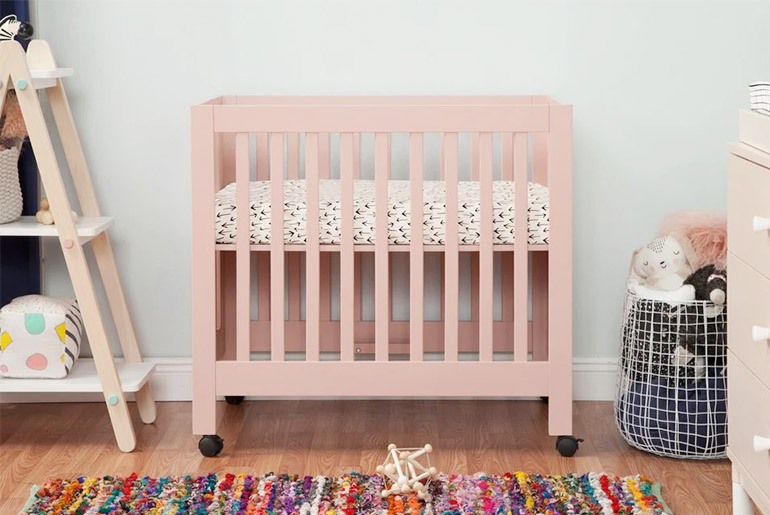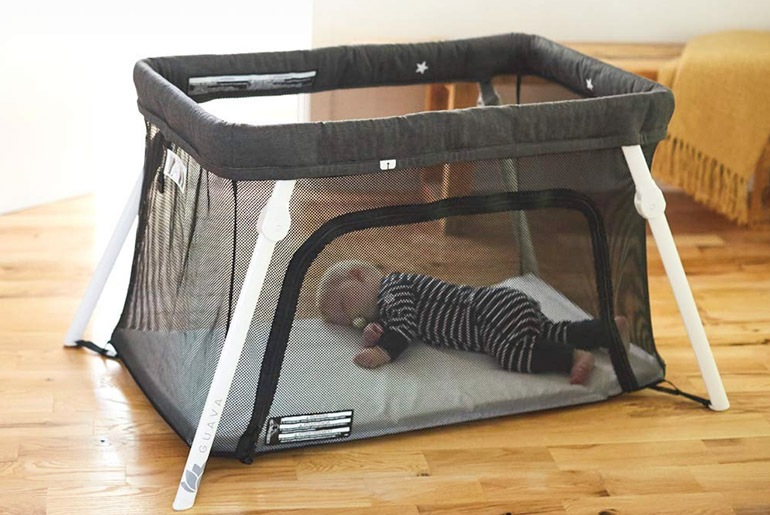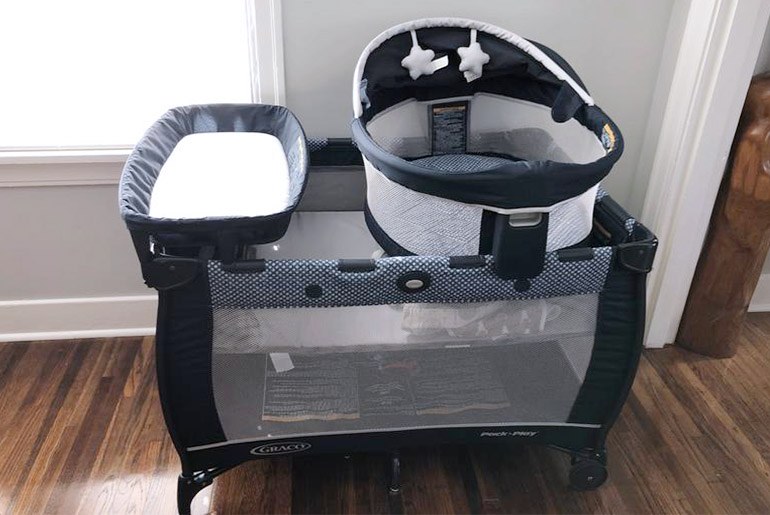Disclaimer: There are affiliate links in this post. At no cost to you, I get commissions for purchases made through these links.
The crib is one of the indispensable items in any baby registry. It’s a private space for babies and parents to practice sleeping habits later. For babies, cribs are like a little house. However, not all families need it but look to other alternatives. Maybe for some reason, like small spaces, or the price of good ones is relatively high.
You can find a lot of different models and substitutes for cribs nowadays. Each type has characteristics and features to serve a particular purpose, from price to portability.
To learn more about these crib alternatives, let’s scroll down.
Do Babies Need Cribs?
A crib is one of the most critical and popular items in the baby registry. Most parents need to use them to support the process of training and arranging sleep for their little ones. However, babies do not need a crib to ensure a comfortable and safe sleep.
There are many alternatives to cribs on the market today. These alternatives have convenience, safety, and prices to suit all financial conditions. Large cribs are often bulky and expensive. Therefore, they aren’t necessary for every family.
Best Crib Alternatives
In this list, each type of product will come with unique functions and characteristics to serve different situations.
1. Baby Lounger Or Nest

A co-sleeping lounger or nest is the most popular alternative to a crib or bassinet for newborns. It’s suitable for most families because of its low cost and ease of use. This lounger provides your little one with a safe space to sleep with their guardians.
The basic shape of the co-sleeping lounger is compact and foldable. It includes a moderately high wall around them to enclose the baby from the outside environment. Thanks to that, parents can ultimately go to sleep without fear of rolling or pressing on the baby, causing suffocation.
The best thing about this lounger is that it maximizes all the advantages you are looking for in a crib for newborns. Besides, high flexibility and easy transportation are also notable plus points.
Most of these shared beds are compact, weighing only about 3 pounds. The sturdy metal frame ensures high strength and long service life.
Manufacturers also often use natural breathable fabrics with mesh surrounds. This material can create ventilation and even highly effective fire resistance. Thanks to this, the baby can sleep comfortably in the lounger, even in the middle of a hot summer night.
In addition, there are many eye-catching and cute designs for you to choose from. Prices only range from $40 to $180. You can consider brands Snuggle Me, DockATot, PharMeDoc, Mamibaby, etc.
Pros
- Lightweight.
- Foldable and easy to move around.
- Reasonable price.
- A safe bed-sharing method.
Cons
- Suitable for six-month-old and below babies only.
- Including pad and sheets are not waterproof.
- It takes up a lot of space in your bed.
2. Mini Crib

If you need crib alternatives for small spaces, mini cribs will be the best choice. They fit into cramped rooms while functioning as a standard crib. However, the use time of these mini cribs can last from one to two years, depending on the baby’s mobility, growth, or the quality of the materials.
The assembly and setup of the sleeper are pretty straightforward when following standard rules. Some models also come with wheels to make moving more convenient and can even be folded for storage.
The application of the mini crib is also very flexible. It allows parents to convert into a bed with a headboard or footboard for toddlers. Their prices range from $150 to $300. You can consider brands like Babyletto, DaVinci, Million Dollar Baby, Dream On Me, etc.
Pros
- Fit into small spaces.
- Affordable for most households.
- The assembly process is straightforward.
- You can move it flexibly.
- Come with the same function as a regular crib.
Cons
- Most sizes are only suitable for children under one-to-two years old.
- It is difficult to find a bed sheet that fits the size of the product.
3. Travel Crib

The third choice on the list is travel cribs that are compact, collapsible, and versatile. The design of this item is quite simple and not too cumbersome like usual Pack ‘N Play models. In fact, babies need a quiet space to sleep. So, limit your selection of annoying products and noises like bells or whistles.
The purpose of this type of crib is to provide the baby with a fixed and familiar place to sleep and play. The whole family can travel together without worrying about this problem.
Babies often have difficulty getting used to their new sleeping environment and are prone to fussiness. So, ensure you provide your baby with the most familiar sleeping environment.
You must also take notice of product safety, especially GreenGuard Gold certification. This certification shows that the crib is free of PVC, phthalates, lead, or heavy metals. Besides, many manufacturers put thin mattresses inside so the baby can lie comfortably. The full-body zipper also makes it easier for toddlers to get in and out.
The average weight of travel cribs is only about 13 pounds and can be folded up easily. Many models can be assembled in minutes. For example, you can fold the Lotus Travel Crib into a 24″ L x 7″ W x 11″ backpack in the blink of an eye.
So, if you’re looking for a crib alternative for travel, this is a decent choice. Their prices range from $50 to $250. You can consider brands like Guava, BabyBjörn, Baby Joy, Phil And Teds, etc.
Pros
- Long-term uses.
- Specially designed for travel.
- Easy to move around the house.
- Affordable.
Cons
- Relatively weak build.
- Quite thin mattresses.
4. Pack ‘N Play

Pack n Play is a sleeper similar in shape to a travel crib in that it’s compact and portable. However, these items also come with several other distinctive features and designs.
The usual and popular design of a Pack n Play often integrates additional bassinets and storage areas. Thanks to that, many parents love this sleeper because it’s multi-functional.
The primary material of Pack n Plays is mostly metal in the frame, and the breathable fabric covers the outside. The mesh fabric surface ensures breathability and air circulation.
It also comes with wheels so you can easily move it around the room. It’s ready to go anywhere when you attach all necessary accessories. Plus, you can easily fold it up for travel with the push of a button like the Graco Travel Dome LX.
The only problem you need to concern yourself with when using pack n plays is their bulky sizes. So you must fold them up if you want to carry them through the doorway.
Most pack-n-plays can be used until your child is three years old. Their prices are lower than cribs and range from $150 to $300. You can consider brands like Graco, Baby Trend, Dream on Me, 4moms, etc.
Pros
- Many accessories included.
- Foldable.
- Standard sizes for any mattresses.
- Reasonable price.
Cons
- Heavy and bulky.
- Some models are difficult to fold up.
- The lining is difficult to remove for cleaning.
5. Bassinet and Bedside Co-Sleeper

Compared with regular cribs, parents should consider adopting bedside sleepers or bassinets as an alternative.
Bassinets come in a wide variety of styles, but what they all have in common is a heavy and sturdy base. The sleeping area is supplemented with mesh panels. The sturdy and heavy base helps limit the risk of the bassinet tipping over in cases where the baby leans out.
Manufacturers have specifically designed them to move or roll up to a hanging sleeping area near your bed. Besides, you can lower the border on one side to bring your little one outside easily for feeding or comforting.
However, when your baby reaches a certain age, about 8 – 10 months, limit the use of bassinets. The reason is that your baby at this age is heavy and strong enough to be able to climb out of the bassinets or bedside sleepers.
In addition, the distance between the floor and the bassinet is relatively high. Therefore, it creates a great danger. This factor is also one of the most significant downsides of these sleepers.
The maximum age your child can use a bassinet or bed sleeper is about one year old, depending on your child’s weight. Therefore, after this time, find another option that works like mini cribs.
The design of bassinets is quite diverse, from simple to smart features. Their prices range from $100 to $400, even as expensive as the SNOO Smart Bassinet. You can consider brands like Halo, Chicco, 4moms, Mika Micky, etc.
Pros
- Affordable.
- Relatively small size.
- Sturdy and heavy construction.
- Easy to get your little one in and out.
- Easy to reposition due to the swiveling top.
- Additional features.
Cons
- Use only for babies under 12 months.
- Difficult to move around the house.
- Too many models to choose from.
6. Floor Bed

The floor bed is another cheap and simple alternative that you can refer to. This item is shaped like a floor mattress so the baby can lie on it.
Safety issues are the essential factors you need to pay attention to when placing your baby on the floor bed. You must protect and shield the surrounding space fully because your little one can crawl out often and get into tight corners. Besides, check the cables and wires of household items to avoid them being pulled down when the baby is moving.
A good recommendation is to put your baby only on an empty floor bed. Pillows and blankets should not be on the mattress as this can cause SIDS.
Babies can roll out at any time during sleep. Therefore, you should choose floor beds that are not too thick or insert a thin mattress next to them to avoid bumps.
If you often travel, choose portable and foldable models. It also makes it easy to store them away when not in use. But the best, in this case, is to choose a travel crib or pack n play as mentioned above.
Pros
- Suitable for tight financial conditions.
- Longevity.
- Portable and moveable.
- It can grow up with your little one.
Cons
- Babies can roll or climb out of the mattress at any time.
- More suitable for toddlers.
- You must cover the bed carefully to ensure safety in all situations.
7. Cardboard Box

Although this option sounds funny and exciting, most families in Europe are adopting this method. Finnish mothers-to-be are often given a cardboard box as a maternity box. This tradition has lasted for 75 years as a welcome gift for babies. In a box, it includes a sleeping bag, overalls, diapers, sheets, toys, a mattress, and bathing products for the baby.
The noble meaning behind this act is that all babies are entirely equal when born from the same starting point. The mattress inside the box will create a safe sleeping space for babies.
Many believe these gifts will limit the infant mortality rate to the lowest. However, according to experts, you still have to pay attention to safety issues when using baby boxes, especially if you plan to make those boxes yourself.
Now, a company in the US called Juno has gradually brought this idea to life. Their cardboard bassinet is lightweight and folds up easily in just 30 seconds for travel convenience. In addition, these cardboard bassinets and their accessories such as mattresses are also certified to meet safety standards by the Consumer Product Safety Council and Greenguard Gold.
You can add different product options to the company’s system in the box. The packaging can even make a nice cardboard box to make a gift.
Pros
- Environmentally friendly.
- It has helped reduce infant mortality in Finland.
- Cheap
Cons
- Small sizes.
- Short lifespans.
Consider These Factors to Find a Good Alternative
Many different factors go into choosing alternatives to baby cribs. You need to evaluate these factors to make the right decision.
1. Baby Age
Your baby’s sleep needs will gradually change over time and at each stage of development. For cribs, be prepared that this option is very brief as the baby will quickly grow out of them.
Floor beds are not suitable for newborns. Babies are usually very active and want to move around a lot, so they will always find a way to get out of bed.
Depending on the baby’s age, your choices may also be determined. Consider the size, personality, growth rate, and precautions.
2. Space Available
You should let your baby co-sleep in the same room for at least the first six months, which is recommended by AAP. Some options available for limited spaces include bassinets, mini cribs, or other similar products.
With babies that have grown up and started sleeping in their rooms, you will have more free space. So, you can equip more items for your little one. These factors provide more choices than ever for parents to consider.

3. Safety Certifications
Baby cribs and alternatives that want to be sold in the US need to pass some particularly stringent regulations regarding safety and quality. According to the US Consumer Product Safety Commission, all cribs manufactured after 2011 must meet their standards.
Only a few of them are mandatory, and others are voluntary. However, you must pay attention to two crucial standards, Greenguard Gold and JPMA.
Greenguard Gold Certification helps confirm that the product is not affected by chemicals and VOCs. It affirms a healthy sleeping and living environment.
Juvenile Products Manufacturers Association (JPMA) is a leading, trusted, independent organization. They’re responsible for children’s products’ authority and quality control.
A JPMA-certified product shows that they meet or exceed ASTM standards, specific retail requirements, and state and federal laws.
Choosing products with these two marks will help ensure your baby’s health.
4. Parental Preferences
This factor is one of the indispensable keys when choosing baby cribs or alternatives.
If you want your baby to co-sleep and feel comfortable, keep doing it. However, when your baby grows up and decides he wants to sleep on his own, respect him and let him do what he wants.
5. Additional Pieces Of Advice
A few other factors that you should pay attention to include the brand of the product. Choose famous and reputable brands in the market. Their products usually have better quality and a more extended warranty period. This deadline is crucial because goods can be damaged or malfunction during transit.
You should also take a look at the overall size of the selection. These alternatives are only for one-year-old babies or younger. Babies grow up quickly, and you’ll soon no longer need that sleeper. Therefore, financial issues are also a pretty stressful factor.
Many parents do not want to spend too much money or a large fortune on one product. So, you can refer to the list to find models with more affordable prices.
The size of the option is also based on the surrounding room space. Space-saving bedrooms will certainly not be able to accommodate a giant crib.

FAQs
1. Should Babies Sleep In Their Own Room From Birth?
In fact, the American Academy of Pediatrics (AAP) recommends that parents let their baby sleep in the same room as their parents. You shouldn’t let your baby sleep alone in a room until he’s six months old.
For optimal safety, wait until your baby is 12 months old and can sleep in her mattress or crib. Keeping your baby close can significantly reduce the risk of Sudden Infant Death Syndrome (SIDS). However, this method has some disadvantages. According to AAP research in 2017, children often don’t sleep and keep their parents up late.
On the contrary, putting children to sleep separately from an early age will help train independence very well. Between four and nine months, your little one will learn to sleep on its own and fall asleep better.
2. Can You Put A 6 Month Old In A Bed?
Six-month-old babies are the best to sleep in a bassinet or crib instead of a traditional bed. Just tut them right in the bedroom shared with the parents. Keeping your little one close will make cuddling, comforting, and feeding easier.
However, limit keeping babies under 12 months old near you. The reason is that newborns are too young to free themselves from their parents’ heavy bedding and arms.
3. Do Co-Sleeping Babies Wake More?
Yes, babies who sleep beside a guardian have a lighter sleep and more frequent midnight awakenings. On average, babies wake up two to three times per night. How often babies wake up is different. In a few isolated cases, children woke up 13 to 15 times per night.
This light and intermittent sleep can have some unique benefits for babies. They aid in interrupting episodes of apnea to prevent SIDS.
Babies often wake up, and exercise will make their heart rate and oxygen levels increase. The immune system and brain need these elements to develop.
4. Can You Sleep If Your Baby Is Awake In Her Crib?
Yes, you can safely put your baby in the crib and sleep while letting them work independently. To get there, start training your little one into effective sleep habits and be able to fall asleep on your own.
You can choose the technique based on two factors: personal preference and the age of the baby. Depending on the given factors, each parent will have a different approach.
Most babies are worried that their parents will leave and become insecure. You’ll want to prevent your baby’s discomfort by being there and comforting them when needed.
6. What Is The Peak Age Of SIDS?
The peak age of SIDS is between two and four months of age. The winter months or early morning hours of sleep are when SIDS is most common. Therefore, it is entirely reasonable to conclude that sleep plays a vital role in the pathophysiology of SIDS.
After the baby reaches six months of age, the risk of the disease decreases rapidly. SIDS will completely disappear by the time the baby is 12 months old.
The Bottom Line
At each stage of the baby’s development, they will need different items. Cribs or crib alternatives are no exception. Each product serves a specific purpose. If your family often moves, choose a travel crib or pack n play.
Bassinet and pack n plays usually offer parents a convenient and comprehensive selection of features. While baby lounger meets the needs of co-sleeping and increases intimacy between parents and children. The mini crib will always be a great choice if you need a durable, convertible option for a small bedroom.
Hopefully, this article can help you make the right decision.



